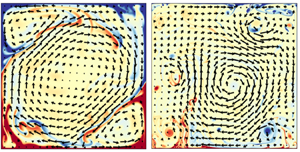Article contents
Flow state transition induced by emergence of orbiting satellite eddies in two-dimensional turbulent Rayleigh–Bénard convection
Published online by Cambridge University Press: 16 October 2024
Abstract

We report a numerical investigation of a previously noticed but less explored flow state transition in two-dimensional turbulent Rayleigh–Bénard convection. The simulations are performed in a square domain over a Rayleigh number range of  $10^7 \leq Ra \leq 2 \times 10^{11}$ and a Prandtl number range of
$10^7 \leq Ra \leq 2 \times 10^{11}$ and a Prandtl number range of  $0.25 \leq Pr \leq 20$. The transition is characterized by the emergence of multiple satellite eddies with increasing
$0.25 \leq Pr \leq 20$. The transition is characterized by the emergence of multiple satellite eddies with increasing  $Ra$, which orbit around and interact with the main vortex roll in the system. Consequently, the main roll is squeezed to a smaller size compared with the domain and wanders around in the bulk region irregularly and extensively. This is in sharp contrast to the flow state before the transition, which is featured by a domain-sized circulatory roll with its vortex centre ‘condensed’ near the domain's centre. Detailed velocity field analysis reveals that there exists an abrupt increase in the energy fluctuations of the Fourier modes during the transition. Based on this phase-transition-like signal, the critical condition for the transition is found to follow a scaling relation as
$Ra$, which orbit around and interact with the main vortex roll in the system. Consequently, the main roll is squeezed to a smaller size compared with the domain and wanders around in the bulk region irregularly and extensively. This is in sharp contrast to the flow state before the transition, which is featured by a domain-sized circulatory roll with its vortex centre ‘condensed’ near the domain's centre. Detailed velocity field analysis reveals that there exists an abrupt increase in the energy fluctuations of the Fourier modes during the transition. Based on this phase-transition-like signal, the critical condition for the transition is found to follow a scaling relation as  $Ra_t \sim Pr^{1.41}$ where
$Ra_t \sim Pr^{1.41}$ where  $Ra_t$ is the critical Rayleigh number for the transition. This scaling relation is quantitatively explained by a phenomenological model grounded on the bistability behaviour (i.e. spontaneous and stochastic switching between the two flow states) observed at the edge of the transition. The model can also account for the effects of aspect ratio on the transition reported in the literature (van der Poel et al., Phys. Fluids, vol. 24, 2012).
$Ra_t$ is the critical Rayleigh number for the transition. This scaling relation is quantitatively explained by a phenomenological model grounded on the bistability behaviour (i.e. spontaneous and stochastic switching between the two flow states) observed at the edge of the transition. The model can also account for the effects of aspect ratio on the transition reported in the literature (van der Poel et al., Phys. Fluids, vol. 24, 2012).
JFM classification
Information
- Type
- JFM Papers
- Information
- Copyright
- © The Author(s), 2024. Published by Cambridge University Press
Footnotes
Z.-Y.G. and X.T. contributed equally to this work.
References
Gao et al. supplementary movie 1
Gao et al. supplementary movie 2
Gao et al. supplementary movie 3
Gao et al. supplementary movie 4
Gao et al. supplementary movie 5
Gao et al. supplementary movie 6
Gao et al. supplementary movie 7
Gao et al. supplementary movie 8
Gao et al. supplementary movie 9
- 3
- Cited by


